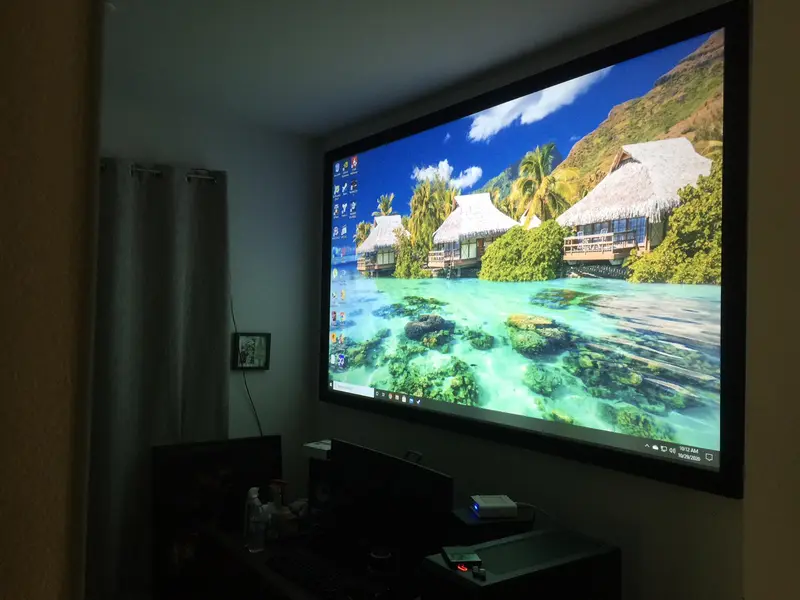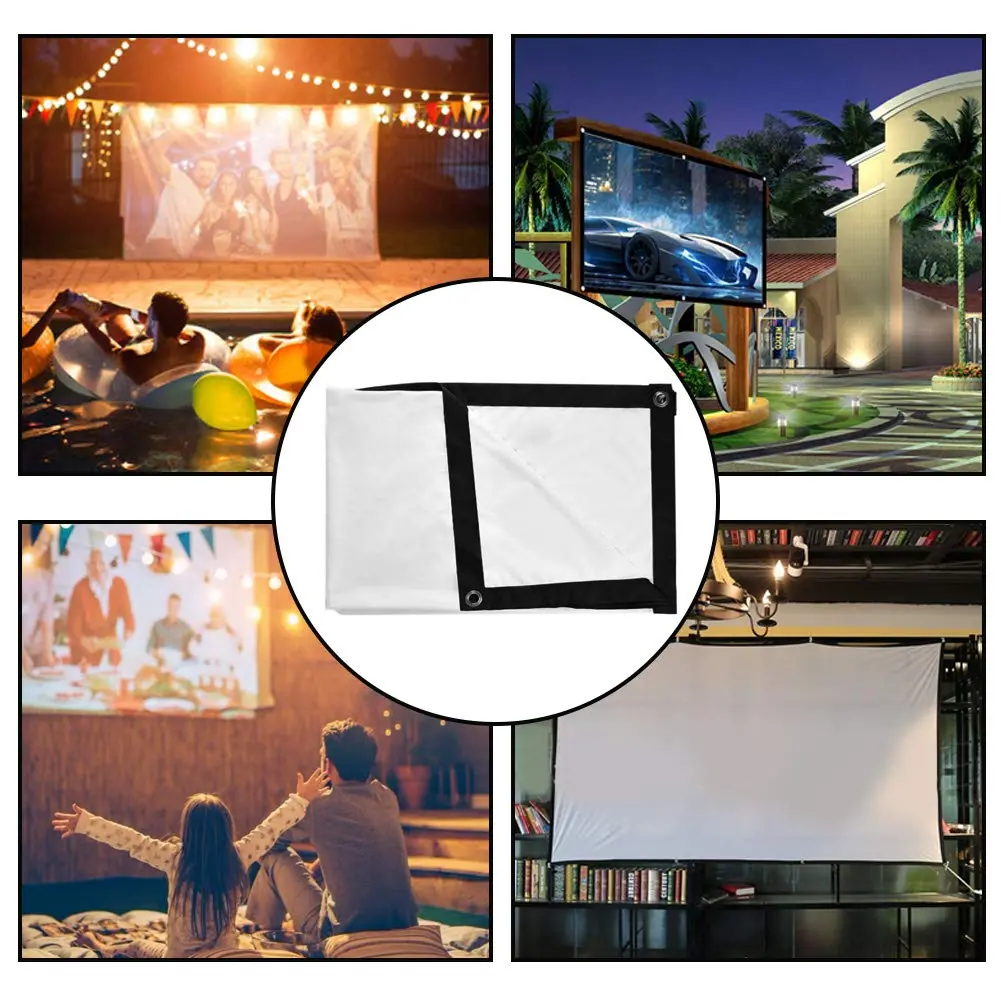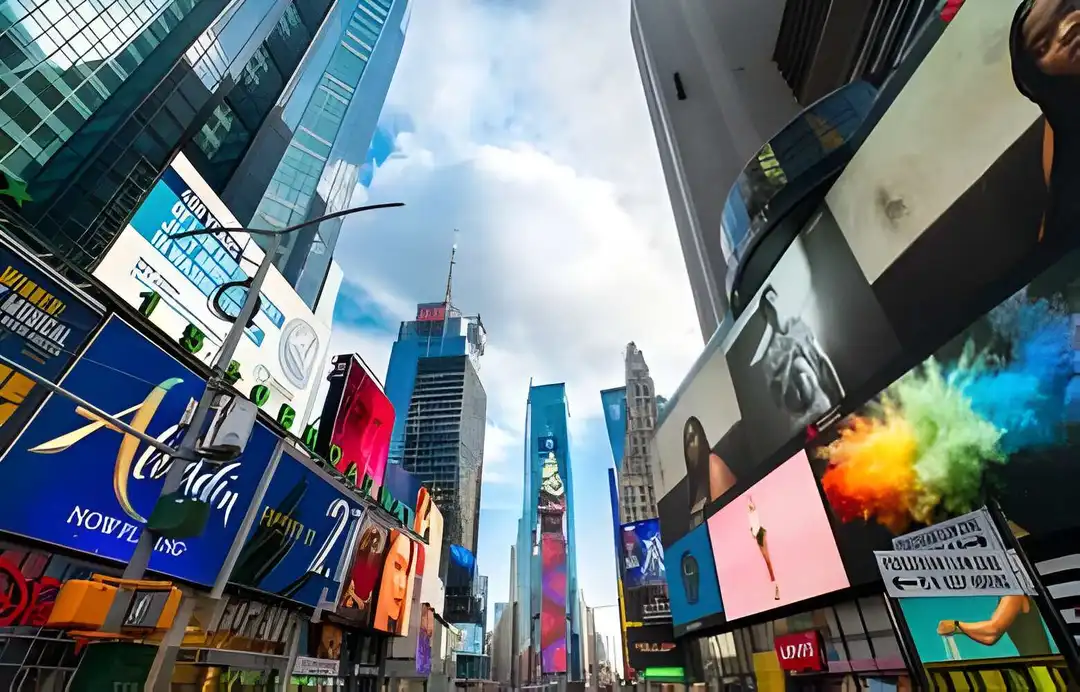If you’re in the market for a projector or already own one, a quality screen is a must-have accessory.
Discover the distinctions between grey vs white projector screens in this article, designed to guide you towards the ideal choice for your needs.
Comparing a Grey and White Screen Surface
If you’re searching for the perfect projector screen, then the screen surface material matters. In addition to a white or grey screen, you can choose between a projector screen or projector paint for your wall. That said, your light conditions are the most critical factor in determining the correct screen type.

Picture Quality
Assuming you have the correct projection environment, your projector unit has the highest impact on your image quality. Modern projectors offer a sharper image than ever before, and your projector screen color should only affect the image brightness. That said, comparing a rear projector screen vs. a front projection would result in noticeably different video images.
Ambient Light Control
Even if you have a high-quality projector, you’ll get poor image clarity if you purchase the wrong screen for your projector environment. Too much light on your screen, and you’ll lose bright colors and image clarity. A white screen is an excellent choice if you have a dark theater. That said, grey projector screens are better for absorbing ambient light from windows or doorways.
Black Level
Since projectors cannot project black, darker tones show better on a grey projector screen. That said, some white surfaces offer high-contrast screens with optical coating for better contrast ratios.
How Do I Choose Between White And Grey?
White materials are usually the best choice for when you have good control over the room lighting – for example if you are showing the screen in a basement with no outside lighting coming in the room.
Grey materials are designed to provide higher picture contrast by lowing the black levels in the projected image. The colors are not as bright as they would appear on a white screen, but grey screens are great for making black in the projected image appear darker and is a great choice for rooms that have some ambient lighting present, since the additional contrast helps overcome image “washout” that happens when unwanted ambient light hits the screen.
Our matte grey material does tend to look more dull than our matte white, simply because of the grey tint on the material – but there is very little color shifting since our factory keeps the tint in the grey range so that the colors themselves do not shift toward blue, red, or any other color shade.
If you have good light control and you are looking for brilliant colors, then you should most likely choose matte white. It is by far our most popular screen material we sell because most people like the way it performs. If you do not have good light control or your projector does not have a lot of contrast, then you may consider matte grey.
Please think of your viewing times. Some people use their projection screen at night to watch movies. Because the viewing of movies is mainly at night a white screen would be perfect for most situations. You may watch sporting events during the day. Sporting events are very bright and do not have deep black scenes during the game. Sporting events look fantastic on a white screen with some light in the room.
Should I Use White Or Gray Projection Screens?
There are two kinds of screen materials widely used for home theater. One is the traditional white that has been in use for decades, and the other is a light to medium gray. The concept of the gray screen was first introduced by Stewart Film screen with their Gray hawk product in 2001, and gray screens have become immensely popular ever since.

Gray screens are often called high contrast screens because their purpose is to boost contrast on digital projectors in viewing rooms that are not entirely dark. The gray screen absorbs ambient light that strikes it better than a white screen does. In so doing the black level on the screen is maintained. This works because, assuming the projector has ample lumen output as most digital projectors do, whites remain satisfyingly white while blacks are maintained at a deeper black. The net effect is to increase the contrast range of the image on the screen.
When the gray screens first appeared in 2001 digital projectors of all types were very much contrast challenged. Thus anything that could help boost contrast performance was a welcome addition to the home theater system. However, during the last three years contrast performance of digital projectors has increased at a rapid pace. Today’s highest contrast projectors claim contrast ratios of up 3000:1 and higher. Though these specs are theoretical in nature and never achieved in real life, the fact is that contrast has improved considerably across the board on all digital projectors in the last three years.
Conclusion: Grey Vs White Projector Screen.
If you don’t have a dedicated home theatre. And you are going to use the projector and the screen in the presence of ambient light. I will suggest you go with the grey projector screen.
And also there are two other reasons to choose the grey projector screen. If you have a low-end projector. Which don’t have a good contrast ratio.
And generally, people choose the grey projector screen. When they want a great black level on the screen. Reason on a grey screen you won’t get the popping color.
If you have a dedicated home theatre. Or you are willing to pay for the black paint for the walls. And also for the black curtains.
Then white projector screen color will be optimal for you. You will get a bright color and a bright image on the screen. The reason why people choose the white color.
FAQ
What’s different about a black screen?
A black screen may seem like an unusual choice, especially in a world dominated by vibrant displays and vivid colors, but it holds its own unique appeal and functionality. What sets a black screen apart from its more common counterparts is its ability to absorb and negate ambient light, resulting in a heightened contrast ratio and improved visibility in specific settings.
Black screens are commonly employed in home theaters and dedicated projection rooms. They excel in these environments by enhancing the depth and richness of projected images. The deep black canvas allows projected content to pop, with dark scenes appearing truly black and bright elements standing out vividly. This heightened contrast adds a cinematic quality to movies and a professional edge to presentations.
Which screen color is best for the outdoors?
Choosing the right screen color for outdoor use is crucial. A high-contrast white screen is the top choice due to its ability to handle intense outdoor lighting, providing clear and vibrant visuals during daytime events. Its versatility makes it suitable for various outdoor occasions, ensuring an engaging and enjoyable experience regardless of lighting conditions.
So, while other screen colors have their moments, like gray screens for controlled indoor spaces, a high-contrast white screen is the hero of the outdoors. It ensures that your outdoor viewing or presentation remains engaging, clear, and enjoyable, no matter what Mother Nature throws your way.
Why do premium projector screens cost so much?
Premium projector screens come at a higher price due to several factors. They use top-notch materials for superior image quality, incorporate advanced technology, offer customization options, prioritize durability, and often come from reputable brands. These screens are designed for specialized applications and a longer lifespan, justifying their cost by delivering an exceptional viewing experience and long-term value. While they may be more expensive upfront, their enhanced performance and longevity can make them a worthwhile investment for those seeking the best possible projection experience.




